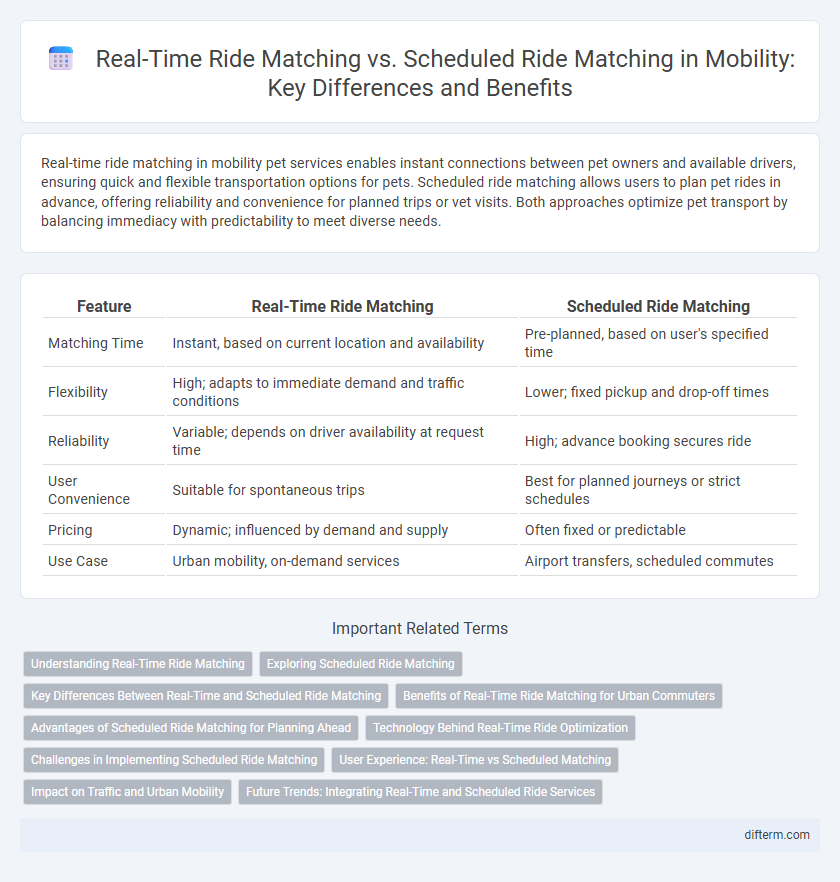Real-time ride matching in mobility pet services enables instant connections between pet owners and available drivers, ensuring quick and flexible transportation options for pets. Scheduled ride matching allows users to plan pet rides in advance, offering reliability and convenience for planned trips or vet visits. Both approaches optimize pet transport by balancing immediacy with predictability to meet diverse needs.
Table of Comparison
| Feature | Real-Time Ride Matching | Scheduled Ride Matching |
|---|---|---|
| Matching Time | Instant, based on current location and availability | Pre-planned, based on user's specified time |
| Flexibility | High; adapts to immediate demand and traffic conditions | Lower; fixed pickup and drop-off times |
| Reliability | Variable; depends on driver availability at request time | High; advance booking secures ride |
| User Convenience | Suitable for spontaneous trips | Best for planned journeys or strict schedules |
| Pricing | Dynamic; influenced by demand and supply | Often fixed or predictable |
| Use Case | Urban mobility, on-demand services | Airport transfers, scheduled commutes |
Understanding Real-Time Ride Matching
Real-time ride matching leverages dynamic algorithms and GPS data to instantly connect drivers and passengers based on current locations and ride requests, optimizing efficiency and reducing wait times. This approach contrasts with scheduled ride matching, which plans rides in advance but lacks adaptability to sudden changes or immediate demand. Understanding real-time ride matching is crucial for enhancing urban mobility, improving ride-sharing utilization, and minimizing empty vehicle miles traveled.
Exploring Scheduled Ride Matching
Scheduled ride matching enhances mobility efficiency by enabling precise alignment of passenger demand with vehicle availability at predetermined times, reducing wait times and improving route optimization. This approach leverages historical data and predictive analytics to forecast peak travel periods, ensuring resource allocation meets anticipated demand smoothly. By prioritizing advance booking, scheduled ride matching minimizes operational costs and increases ride-sharing opportunities, contributing to sustainable urban transportation.
Key Differences Between Real-Time and Scheduled Ride Matching
Real-time ride matching connects passengers with nearby drivers instantly using GPS and dynamic algorithms, optimizing wait times and route efficiency. Scheduled ride matching involves pre-arranged bookings, allowing for planned trips but less flexibility in timing and route adjustments. Real-time systems prioritize immediate demand response, while scheduled matching emphasizes predictability and advanced planning.
Benefits of Real-Time Ride Matching for Urban Commuters
Real-time ride matching significantly reduces waiting times for urban commuters by instantly connecting riders with nearby drivers through dynamic algorithms. This technology adapts to traffic fluctuations and route changes, enhancing ride efficiency and lowering congestion in city centers. Real-time matching also increases flexibility, allowing commuters to request rides on-demand without prior scheduling, which suits unpredictable urban travel patterns.
Advantages of Scheduled Ride Matching for Planning Ahead
Scheduled ride matching enables commuters to plan trips with precision, securing rides in advance to avoid last-minute availability issues. It improves resource allocation for transportation operators, optimizing vehicle routes and reducing wait times. This approach enhances reliability and convenience, particularly for regular, time-sensitive journeys such as daily commutes or airport transfers.
Technology Behind Real-Time Ride Optimization
Real-time ride matching leverages advanced GPS tracking, machine learning algorithms, and dynamic data analytics to optimize route efficiency and reduce passenger wait times compared to scheduled ride matching. Technologies such as predictive demand modeling and real-time traffic analysis enable platforms like Uber and Lyft to match riders instantly with nearby drivers, enhancing overall system responsiveness. Integration of IoT sensors and edge computing further refines ride allocation by continuously updating driver availability and traffic conditions, resulting in more precise and efficient ride optimization.
Challenges in Implementing Scheduled Ride Matching
Implementing scheduled ride matching faces challenges such as predicting demand variability, managing dynamic route adjustments, and ensuring rider punctuality to avoid delays. Unlike real-time ride matching, scheduled systems must effectively coordinate multiple pickups while minimizing wait times and optimizing vehicle utilization. Advanced algorithms and accurate forecasting data are critical to address these complexities and maintain operational efficiency.
User Experience: Real-Time vs Scheduled Matching
Real-time ride matching offers users immediate ride availability, reducing wait times and enhancing convenience by dynamically connecting drivers and passengers based on current locations. Scheduled ride matching improves predictability and planning by allowing users to book rides in advance, ensuring timely arrivals for appointments or events. Both methods enhance user experience by balancing spontaneity and reliability to meet varying mobility needs.
Impact on Traffic and Urban Mobility
Real-time ride matching optimizes traffic flow by dynamically pairing riders and drivers based on current demand, reducing wait times and unnecessary detours. Scheduled ride matching allows for planned routing and better resource allocation but may lead to less flexible traffic adjustments during peak hours. The combination of both methods can enhance urban mobility by balancing efficiency and predictability in transportation networks.
Future Trends: Integrating Real-Time and Scheduled Ride Services
Future trends in mobility emphasize the seamless integration of real-time ride matching with scheduled ride services to enhance efficiency and user experience. Advanced algorithms leverage AI and machine learning to dynamically allocate vehicles based on real-time demand while optimizing pre-scheduled rides to reduce wait times and maximize fleet utilization. This hybrid approach supports sustainable urban mobility by balancing immediate ride requests with planned journeys, ultimately driving smarter transportation ecosystems.
real-time ride matching vs scheduled ride matching Infographic

 difterm.com
difterm.com